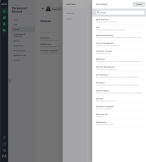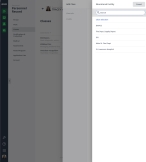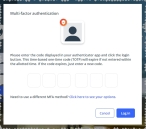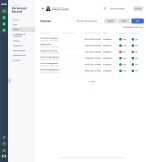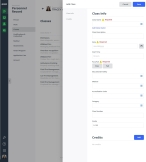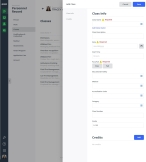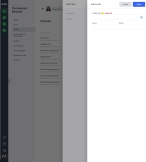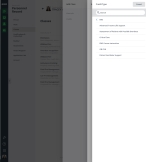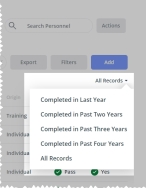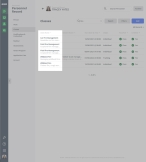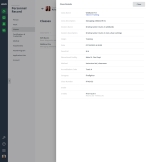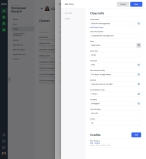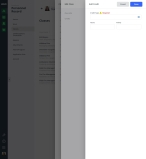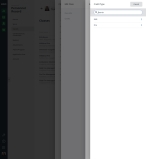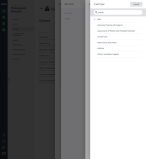Update class information
A training class is a class given to develop your staff members' skills. Training classes can be credited toward any training requirements for the person, agency, or department.
Note: You must have the full version of PM to update training class information.
For information on upgrading to the full version of PM, go to https://www.eso.com/pm-demo/ and fill out the fields to request a demonstration and speak with a sales representative.
In the PM and Admin modules, your PM and Admin administrators can configure a number of important lists you need when creating and working with training classes. Some of the lists exist in the PM module, on the Settings pages; other lists exist in the Admin module, in the PM pages.
In the PM module, an administrator needs to review and define class-related lists on the Settings > Class Lists page, for the following:
-
Class Names
-
Session Names
-
Absence Reasons
-
Credits
Note: These lists may have been initially populated through importing class data from a spreadsheet, and the administrator may need to manually update or disable imported list items, and add more items to the lists. The administrator can also add values in class-related lists by performing additional class data imports from spreadsheets.
Information on importing class data is available in Import data.
These list items appear when you click the corresponding fields in the PM module.
|
Example: When creating class records, you may need class name options such as ABLS Instructor, ACLS, Car Fire Management, Computer Training, Field Fire Management, and so forth. Your PM module administrator must add custom ADL items to the PM module, on the Settings > Class Names screen, for items to appear as menu choices. The administrator must also verify that the ADL items are enabled for them to appear; items that are disabled on the Settings > Class Names screen will not appear as options for the Class or Class Name field. |
Information on creating a class names list is available in Set up training classes.
If no options appear, or if the menu does not have an option that meets your needs, contact your PM module administrator and ask them to add the necessary menu choices. You will need to work closely with your administrator to create and maintain these lists, as your department's needs evolve over time.
In the Admin module, an administrator needs to define class-related lists of items under the following, for adding or filtering the list of personnel in the PM module.
-
PM > Class Lists >
- Training Location
- Education Facility
- Class Method
- Categories
- Accreditation Code
These list items appear when you click the corresponding fields in the PM module.
|
Example: In the PM module, for the Education Facility field, you may need options such as St. Lawrence Hospital, Main St. Fire Depart., Fire Supply Supply Depot, ISU, DMACC, and so forth. Your ESO Suite administrator must add corresponding ADL items in the Admin module, under PM > Class Lists > Education Facility, for these items to appear as menu choices in the PM module. |
Information on defining class-related list menu options in the Admin module is available in Build class lists.
If no options appear in a class-related field with a drop-down menu, or if the menu does not have an option that meets your needs, contact your Admin module administrator and ask them to add the necessary menu choices. You will need to work closely with your administrator to create and maintain these lists, as your department's needs evolve over time.
-
 (If you have not done so already) Access the PM or PM Basic module in the ESO Suite.
(If you have not done so already) Access the PM or PM Basic module in the ESO Suite.
Which version of the module opens depends on whether your agency or department has purchased the PM Basic or full version of the PM module.
-
Do one of the following.
-
(If you are already working in the ESO Suite) Click the Home icon in the upper left corner of the screen.
-
 (If you have not yet logged in) Log in to the ESO Suite.
(If you have not yet logged in) Log in to the ESO Suite.
-
In a web browser, go to https://www.esosuite.net/EsoSuite.
The ESO Suite login screen appears.
-
Enter your user name, password, and agency name, then click Let's Go.
If MFA is enabled, the Multi-factor authentication dialog box appears, displaying one or more methods you can use to verify your login credentials. The number of methods that appear in the dialog box depends on what MFA methods your ESO Suite administrators enabled in the Admin module.

Click graphics
to open them.Information on enabling MFA and specific MFA methods is available in the Admin module online help, in Configure multiple-factor authentication.
Note: If your ESO Suite administrators have disabled MFA ("opted-out"), this dialog does not appear.
-
(If the Multi-factor authentication dialog box appears) Depending on which buttons appear in the dialog box, verify your login in one of the following ways.
 With an authenticator application.
With an authenticator application.
-
Click MFA verification via authenticator app.
The dialog box updates with boxes for entering the numbers of the authentication code, and the ESO Suite sends an authentication code to the authenticator application installed on your device.
-
Open your authenticator application and note the authentication code currently displayed.
-
Enter the authentication code displayed in the authenticator application.
-
Click Log In.
 With a text message (SMS).
With a text message (SMS).
-
Click MFA verification via SMS.
The dialog box updates with boxes for entering the numbers of the authentication code, and the ESO Suite sends an authentication code to the phone number recorded in your PM records and identified with MFA codes.
-
Enter the authentication code sent to your MFA-registered phone number.
-
Click Log In.
 With an email message.
With an email message.
-
Click MFA verification via email.
The dialog box updates with boxes for entering the numbers of the authentication code, and the ESO Suite sends an authentication code to your agency or department email address, recorded in your PM records.
-
Enter the authentication code sent to your agency or department email address.
-
Click Log In.
-
-
The ESO Suite landing screen appears.
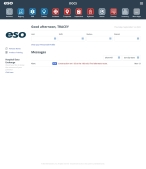
Click graphics
to open them.Note: If MFA is enabled, you can access and manage your MFA options through the PM module, on the Settings > Account page, as described in Manage a user account. If your agency or department has enabled MFA but has not purchased the full-featured version of the PM module, you can access your own MFA settings by clicking Change my Multi-Factor Authentication settings on the landing screen, then using the Settings > Account page that appears. If your agency has not enabled MFA, the Change my Multi-Factor Authentication settings link does not appear on the landing screen.
-
-
On the top side of the home screen, click PM.
Tip: If your screen or browser window is too narrow to display all your agency's ESO Suite module icons, an options icon appears on the right side of the icon bar. If you click the options icon, a menu appears containing additional module icons.
A list of all the personnel in the PM module appears, displayed in a grid format.
PM (full version) PM Basic Note: If you can access the full-featured PM module, you can view all your own information in it. The amount of information you can edit in the PM module depends on what roles and permissions your ESO Suite administrator assigned to your user account.
Information on user accounts, roles, and permissions is available in Manage a user account.
-
-
(If you have not done so already) Open the record of the person you want to work with, as described in Display, filter, and export personnel lists.
The personnel record opens and displays the page relevant to the list you were working with.
-
On the left, click the Classes bookmark.
The contents of the Classes page appear.
-
Do any of the following.
 Add a class to the person's record.
Add a class to the person's record.
-
On the right side of the Classes section, click Add.
The Add Class dialog box appears on the right, set to the Class Info section.
-
 Describe the class.
Describe the class.
-
For Class Name, click the field or the list icon to the right of the field, then select the appropriate single option from the menu that appears.
Note: The options that appear in the menu were added earlier by your PM administrator in the Settings screen, under Class Lists > Class Names. If the class name you need does not already exist in the Class Name's menu, and if you have the necessary permissions in the PM module, you can add a new class name as a menu option without going to the Settings screen.
 Add a class name while on the Classes page.
Add a class name while on the Classes page.
-
Under the Class Name field, click Add Class Name.
The Add Class Name dialog box appears.
- In Class Name, type the name for the class.
- In Class Description, type a short description of the class.
-
In Class Objective, type the list of objectives the class will cover.
An objective is a knowledge base and/or set of skills taught during a training class.
-
Click Save.
The class name you created appears as a new menu option in the Class Names field. The class name also appears in the Settings screen of the PM module, under Class Lists > Class Names.
-
- In Class Description, type additional text for more fully describing the class.
- For Date, click the calendar icon on the right end of the field and select the appropriate date from the calendar that appears.
- In Start Time type the times the class begins, in military time.
- For Pass/Fail, click either Pass or Fail to indicate whether or not the person passed the class.
-
For any of the following fields, click the field or the list icon to the right of the field, then select the appropriate single option from the menu that appears.
Note: Your ESO Suite administrator must have added ADL items in the Admin module, under PM > Class Lists, for these fields to have menu choices in the PM module.
Field Information needed Educational Facility
The educational credentialing system that your local program or external programs fall under. If your agency is certified by your state as an educational facility, you can use the agency's name as the education facility. If your crew members and staff utilize external facilities, use the information about those facilities.
Method
The methods of instruction used in your agency's training programs, such as lecture, classroom, lab, hands-on, video, and so forth.
Accreditation Code
The code the credentialing authority such as ISO, NREMT, or NFPA, uses to identify the class.
Category
Broad-based themes by which classes are grouped together into categories.
- In Class Number, type the number your agency use to identify the class for internal record keeping.
- In Grade, type a numerical value between 0-100, to indicate the person's score or grade in the class.
-
-
 Record credits earned for the class.
Record credits earned for the class.
A credit is a unit that counts towards receiving or renewing a certification or license, such as continuing education credits, to receive or renew a credential, qualification or skill, or for a state or national requirement such as ISO. You can use credit points to track LOSAP or other award programs, and to track training requirements. LOSAP is as a system established to provide tax-deferred income benefits to active volunteer members of an emergency service organization.
-
On the left, click the Credits bookmark.
The right side scrolls down to the Credits section of the dialog box.
-
On the right side of the Credits section, click Add.
The Add Credit dialog box appears.
-
For Credit Type, click the field or the list icon to the right of the field.
A list of credit categories appears.
-
Click the right-pointing arrow for the category the credit you want to add would be in.
A list of credits specific to that category appears.
Example: If you chose EMS as the category, a list of EMS credit selections appears.
-
Select the option corresponding to the credit you are adding.
The Add Credit dialog box becomes visible again.
-
In Hours, type the number of hours granted for the class.
Hours can be applied toward certification or a CEU.
- In Points, type the number of points the person received toward this credit type.
-
Click Done.
The Add Credit dialog closes, the Add Class dialog box becomes visible again, and the credit you added appears in the Credits section of the dialog box.
-
-
Click Save.
The information you entered appears as a summary in the Classes page.
 Find the class you want to work with.
Find the class you want to work with.
Note: The filtering methods below all work in conjunction.
Example: You can initially filter the list by class names, then reduce the list further by searching for specific words in the class description, then sort those results alphabetically or by when they were completed.
 Sort the classes by ascending or descending values in columns.
Sort the classes by ascending or descending values in columns.
-
At the top of all the columns, click the column sort (
 ) icon.
) icon.The ascending values (
 ) icon appears, and the column sorts from A–Z, or from 1 to the highest numerical value.
) icon appears, and the column sorts from A–Z, or from 1 to the highest numerical value. -
Click the ascending values icon to sort the list into descending order.
The descending values (
 ) icon appears, and the column sorts from Z–A, or from the highest numerical value to 1.
) icon appears, and the column sorts from Z–A, or from the highest numerical value to 1.
 Use filters to reduce the person's class list.
Use filters to reduce the person's class list.
The PM module applies the filters you select in the steps below in a logical AND construction, to reduce the matches with each additional criteria you use.
-
In the upper right corner, click Filters.
The Filters dialog box appears on the right side of the screen.
-
For any of the following fields, click the list icon to the right of the field, then select all the appropriate options from the menu that appears, and click Done.
Field Searches for this Class Name
The name for the class, as defined by your PM administrator on the Settings > Class Lists > Class Names screen.
 Understand how class names defined on the Settings screen appear as menu options in the PM module.
Understand how class names defined on the Settings screen appear as menu options in the PM module.
The class name menu options you define and enable on the Settings screen, under Class Lists > Class Names, appear when you click the Class or Class Name field, or when you filter for a class in the PM module.
Example: When creating class records, you may need class name options such as ABLS Instructor, ACLS, Car Fire Management, Computer Training, Field Fire Management, and so forth.
Your PM module administrator must add custom ADL items to the PM module, on the Settings > Class Names screen, for items to appear as menu choices. The administrator must also verify that the ADL items are enabled for them to appear; items that are disabled on the Settings > Class Names screen will not appear as options for the Class or Class Name field.
If no options appear, or if the menu does not have an option that meets your needs, contact your PM module administrator and ask them to add the necessary menu choices. You will need to work closely with your administrator to create and maintain these lists, as your department's needs evolve over time.
Information on creating a class names list is available in Build the class names list.
Category
Broad-based themes by which classes are grouped together into categories.
Method
The methods of instruction used in your agency's training programs, such as lecture, classroom, lab, hands-on, video, and so forth.
The filters you selected appear directly on each of the filter buttons.
-
Click Done.
The Classes screen updates to list all classes that match the criteria you selected. The criteria you specified appears across the top of the screen.
-
 (Optional) Remove criteria to widen the current custom search results.
(Optional) Remove criteria to widen the current custom search results.
-
At the top of the current custom search results, click the X (close) button on one or more filters at the top of the list.
The list updates with items matching the remaining criteria.
Example: In the search results below, one of the criteria is Class Name = Field Fire Management.
If you click the X (close) button for that criteria, the class list updates to display classes of any status, categorized for EMS or firefighter (Category = EMS, Firefighter), and that were taught by an instructor, out in the field (Method = Instructor-led, in the field).
-
Note: If you want to filter the list by only one of the methods above, such as by class description, be certain that the list is not already reduced with one or more of the other methods.
Tip: You can tell at a glance if the list is filtered by class description if part or all of a word appears in the search bar on the left side of the page. You can also tell at a glance if other filters are applied if filter names across the top of the class list, and by the value selected for the Completed in field.
 View a class taken with multiple attendees.
View a class taken with multiple attendees.
-
Click the listing for the class you want to view.
The Class Details dialog box appears.
Note: If the value in Origin is
ESO Training, then the training class was created on the Training screen in the PM module. If you have the appropriate permissions in the PM module, the View in Training link appears below the class name. -
Click View Class In Training.
The Class page appears, listing the complete information for the training class.
- Review the information in the fields as needed.
 Edit or delete a class the person took as an individual, or was imported.
Edit or delete a class the person took as an individual, or was imported.
The PM module identifies imported class records in the Origin field as either
ImportedorImported fromsource.Example:
Imported from FirehouseorImported from Lexipol.-
Click the listing for the class you want to edit or delete.
The Class Details dialog box appears.
Note: If the value in Origin is
Individual, and if you have the appropriate permissions in the PM module, the Edit and Delete links appear below the class name. -
Depending on your needs, do one of the following.
 Edit the class information.
Edit the class information.
-
Under Class Name, click Edit .
The Edit Class dialog box appears, displaying the information already specified for the class.
- Change the information in the fields as needed.
-
On the left, click the Credits bookmark.
The right side scrolls down to the Credits section of the dialog box.
-
 (If necessary) Do any of the following.
(If necessary) Do any of the following.
 Add credits earned for the class.
Add credits earned for the class.
A credit is a unit that counts towards receiving or renewing a certification or license, such as continuing education credits, to receive or renew a credential, qualification or skill, or for a state or national requirement such as ISO. You can use credit points to track LOSAP or other award programs, and to track training requirements. LOSAP is as a system established to provide tax-deferred income benefits to active volunteer members of an emergency service organization.
-
On the right side of the Credits section, click Add.
The Add Credit dialog box appears.
-
For Credit Type, click the field or the list icon to the right of the field.
A list of credit categories appears.
-
Click the right-pointing arrow for the category the credit you want to add would be in.
A list of credits specific to that category appears.
Example: If you chose EMS as the category, a list of EMS credit selections appears.
-
Select the option corresponding to the credit you are adding.
The Add Credit dialog box becomes visible again.
-
In Hours, type the number of hours granted for the class.
Hours can be applied toward certification or a CEU.
- In Points, type the number of points the person received toward this credit type.
-
Click Done.
The Add Credit dialog closes, the Add Class dialog box becomes visible again, and the credit you added appears in the Credits section of the dialog box.
 Edit a credit.
Edit a credit.
-
In the listing for the credit you want to edit, click Edit.
The Edit Credit dialog box appears, displaying the information already specified for that credit.
- Change the information in the fields as needed.
-
Click Done.
The Edit Credit dialog closes, and the Edit Class dialog box becomes visible again.
 Delete a credit.
Delete a credit.
-
In the listing for the credit you want to delete, click Delete.
A confirmation dialog box appears.
- Click Yes.
-
-
Click Save.
The Class Details dialog box reappears.
- Click Close.
 Delete a class.
Delete a class.
-
Under Class Name, click Delete.
A confirmation dialog box appears.
- Click Yes.
-
-
-
 (Optional) Export the class list.
(Optional) Export the class list.
You can export a list of all the classes you have taken. The list exports to a comma-separated values (*csv) file, which may be read with Microsoft Excel or other software applications, and includes each class's name, description, objectives, category, instructor's name, session information, and more.

